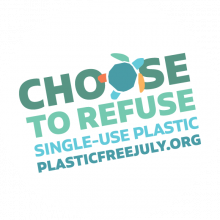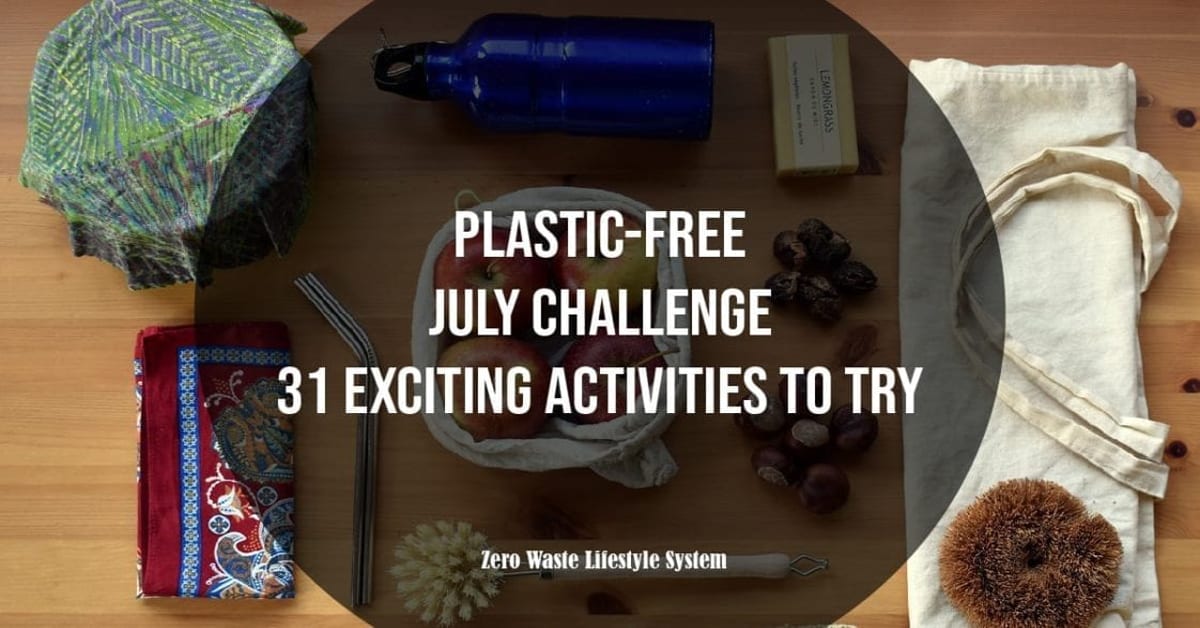Plastics. We know how tacky this material is. Only having an average of 15 minutes working life, yet its impact is felt everywhere—even by the ocean floor! Its threats are almost forever.
Every day, more than 8 million tons of plastics goes into ocean. This statistics does not even account for those which goes to landfills, those that are burnt, or those that stays in the community. For a world that has an approximately 7.8 billion population, this plastic trash is something.
On average, the plastic waste produced yearly is 381 million tons. Worse, 50% of this are single-use plastics. Only 9% gets recycled.
That’s why this July, we are bringing you the solution—a plastic-free month.

The Plastic Free July movement first started in 2011. It is an initiative that aims for a world that has no plastic waste. In 2019, 250 million participants already joined the campaign. And they have avoided 825 million kilograms of plastics in total.
However, the problems on plastics are not shared only by that 250 million population. Around the world, there is an infinite number of living organisms from various species that suffocates from the immortal enemy—plastics. We want you to get involved.
31 Daily Challenges for Plastic Free July
You can always customize your calendar depending on your day-to-day activities. But to make things less complicated for you, the Zero Waste Lifestyle System gathered these 31 challenges that will kickstart your Plastic Free July challenge.
I asked bloggers, sustainability experts, eco-conscious entrepreneurs, and other industry experts about plastic-free activities. Learn from their insights and get inspired to commit to go plastic-free.
Do a trash audit. – Callee Ackland of Bestowed Essentials
You have to know what the problems are before you can fix them. Look at your trash every week for a month to see where you are creating the most waste. Then see what you can change from there.
Use up what you have.
When you are just starting in your zero waste journey, gather everything you have to consume from the kitchen to the bathroom. Take inventory, use them up, and slowly replace these products with plastic free versions as needed.⠀
Build your zero waste kit
Callee Ackland, who also owns Hippie Haven shop, the first zero waste store in South Dakota says, “One of the best ways you can avoid plastic is to plan ahead. Build your own “zero waste kit” out of items you already have. You might be surprised at how much waste you avoid by bringing a reusable bag, mason jar, fork, spoon, knife, napkin, and straw. Keep it in your car or bag for avoiding waste on the go.”
Give life to old plastics
With so much stuff in an average home, chances are these stuff have materials made of plastic. Instead of throwing them away after you use them, why not upcycle them? You can revamp an old dress into a contemporary outfit. Or had a makeover in your old furniture. The upcycled item can be perfect for your style again. If not, give them to someone you know will appreciate these items.
Take the label off jars and reuse them – Bri Bell, Frugal Minimalist Kitchen
“Take the label off jars so you can reuse them. Simply soak the jars in hot water, then peel off the label. If there’s sticky glue residue, rub on a few drops of oil and let it sit. Scrape the goo off with a dull knife, then wash with soapy water.”
Coffee grounds for fertilizer – Francesca Hess
A nifty Plastic-free July tip is to re-purpose coffee grounds. Use coffee grounds as a base for fertiliser!
Embrace a borrowing mindset – Stephanie Seferian, Mama Minimalist
“Many of us rush to the store (or to Amazon) every time we need to acquire an item. But buying items we don’t truly need to own creates excessive and unnecessary plastic packaging waste. Borrow items you need from members in your community whenever possible. Alternately, consider purchasing secondhand instead of new, as doing so will have far less – if any – packaging.”
No new clothes challenge – Mary Bemis, Reprise Activewear
“Right now over 60% of our clothing today is made with plastic (polyester and nylon being the most common two) which relies on big oil companies for production (both virgin and recycled polyester) and pollutes millions tiny microplastics into our water sources during laundry and are ending up in our food supply. I propose a challenge in Plastic-Free July to buy no new clothing to address our reliance on plastic in non-obvious ways like clothing.”
Refuse free stuff
Stephanie Seferian also recommends just saying no, even if if you’re offered things for free. She says, “Free pens. Lighters. Ketchup packets. If you don’t need it, don’t take it. Save such items for others who actually do need them, instead, and create less plastic waste in the process.”
Refuse plastic bags for groceries – Mira Rakicevic, ComfyLiving
“This might seem easy, but many of us that have attempted to make a habit out of bringing our own grocery bags always end up forgetting them at some point. As hard as we try, there is always that day where bags are left at home or in the car. In July, challenge yourself to bring a re-usable grocery bag every single time, even if you need to write it on your arm like in elementary school. Every plastic bag avoided helps save our planet, a little bit at a time.”
Refuse processed foods or ready-to-go meals – Margarita Samsonova, Margaventure
“Those are convenient but often come in non-recyclable packaging. Cook more at home and prepare foods from scratch. So you will avoid a lot of plastic waste.”
Refuse take outs
“If you go to a restaurant, enjoy a meal on your plate. If you go to a coffee shop, enjoy the pleasure of quietly drinking a cup of coffee inside. If you are in a hurry, remember to bring your own coffee mug and tupper to take away in a sustainable way!”
Skip the snack pack
From convenience, the supermarket abounds with individually-wrapped snacks (i.e. single-serving cheese sticks, miniature bags of `chips, single-serve juice boxes, little yogurt cups, et cetera). Thanks to all that unnecessary packaging, these items create excess waste. Skip these items and instead buy your preferred foods in the largest sizes possible then separate yourself at home into individual-sized portions.
Avoid plastic bottled water. – Ahmed Ali of Heart Water
By purchasing plastic water bottles, we are contributing to the plastic epidemic. With over 1 million plastic bottles produced around the world per minute, take a stand against the plastic epidemic that is not only hurting our environment but also animals, oceans, and ultimately, the human population. Choose to use your own jars or get reusable containers.
Get yourself a reusable water bottle
“Get yourself a reusable water bottle! This is the easiest thing you can do for yourself and the environment, and a single reusable bottle can last you for years and can save thousands of plastic bottles from going to the landfill.”
Invest in thermos
If you are particular with the temperature of your drink, get a thermos. Challenge yourself to buy juice and soda in bulk, so you can refill your thermos instead of tossing single-use plastic bottles in the recycling bin. If we all bought only products with glass containers at the grocery store, we can save a lot of plastic. So no more single-use coffee cups, microwavable soups and orange juice in disposable containers use a thermos instead to help cut down on plastic.
Refuse soda wrapped in plastic.
Avoid purchasing soda with plastic rings, even if you cut them up (it’s still harmful). Instead, buy the larger packs of soda that come in boxes.
Avoid tampons
If you’re a woman, it’s really difficult to avoid plastic when it comes to period products. One important step for Plastic-Free July is to go zero waste in your menstrual care. Invest in a menstrual cup, cloth napkins, or reusable period underwear. Although a lot of women frown upon the idea of menstrual cups, it’s one of the best eco-friendly menstrual products. They do take a few cycles to get used to, but they’re awesome once you do. They last so much longer than tampons – which are often made from plastic!
Change the way you shave. – – Laurice Wardini, ClothedUp
Use replaceable blade razors. This doesn’t have to be expensive – look for both locally made and sustainable options.
Thrift shop, especially for clothes
“If you’re trying to budget, it can be hard to avoid synthetic materials (clothing made of natural, sustainable materials can be more expensive). If you can’t afford to buy sustainable clothes, I’d recommend thrift shopping at local stores or on online retailers (such as ThredUp, Poshmark, Mercari, etc.)”
Shop local
Aside from getting a fresher and healthier produce, purchasing from local farmers do not use excessive plastic packaging. In fact, a lot of farmers now are adopting ways to reduce their plastic consumption. Some local farms use leaves in wrapping their produce. Others, plant-based strings to tie a bunch of product. If not, you can just have them put in your reusable bag.
Shopping locally also helps you support small businesses. Here you help your community grow and be more sustainable in development. Do this even beyond the Plastic-Free July challenge.
Shop with plastic-free packaging.
Buy from from companies who only use recyclable, plastic-free packaging. There are bulk stores that cater to certain states and localities.
With the pandemic around the corner, we almost always buy our needs online. If you are new to zero waste shops, why not try them this month? These shops practice responsible production of their goods to save the planet.
Buy from Etsy
If you don’t want to make your own, there is quite an array of plastic-free companies on Etsy for any product you can imagine. Plus, you’re supporting small businesses.
Refuse plastics in Amazon
If you shop on Amazon, it’s better to combine all of your packages onto one day and write in the notes section that you don’t want plastic packaging.
Choose compostable options – TIPA
“In cases where packaging is unavoidable, or you find yourself without a refill station in your neighborhood, avoid plastic packaging at the supermarket by choosing compostable options (paper, fully compostable plastics) that will compost with your organic and food waste. Some cities have community composting or commercial composting facilities with pick-up or drop-off services. If you don’t have a composting facility near you, consider starting your own home compost.”
Beeswax wraps instead of plastic wraps
Beeswax wraps are great alternatives to plastic wrap and you can pop them in the oven when they age.
Switch to shampoo and conditioner bars – Sara Taha of Sufeya Boutique
“One of the best ways to reduce your plastic waste is to use shampoo and conditioner bars. One shampoo bar can be the equivalent of up to 3 liquid shampoo bottles! Just look for handmade natural shampoo bars as they come consciously packaged and as a bonus, they are less packed with harmful chemicals.”
Use refillable coffee pods
If you use keurigs or other coffee pod machines, so much plastic is wasted. Luckily, you can still enjoy your machine with reusable coffee pods that you fill with your own coffee.
Plastic recycling competition
A good idea for getting the kids and younger ones involved in Plastic-Free July is to have them compete to see who collects the most plastic. You can send the kids out on a neighbourhood watch for plastic, and whoever picks up the most plastic at the end of the day gets a reward. Not to make it individualistic, you can also call it a pizza night if they collectively gather a certain number of plastic bags, to help associate the activity with something the kids really enjoy doing. This can become a weekly event, with parents rotating who hosts the competition, and pays for the pizza of course!
DIY some of your personal care routine
One of the best hobbies to take up during this pandemic when you’re stuck at home is to make soaps, shampoos (plus other non-essential bath products). Laurice Wardini says, “At first, I was just trying to avoid plastic, but it’s become so fun! It’s also easy and saves money. I have made shampoo bars, conditioner, bubble bars, lotions, face oils, and lip scrubs.”
Try gardening or regrowing food at home
One of the best but arguably hardest activities in Plastic-Free July is to start a garden. You can do this in your lawn or indoors.
This will allow you to stay away from veggies packed in plastic and it’s a satisfying experience. Not only is it very fulfilling to see something grow from your efforts, you get also get the benefits of fresh, wholesome food. Plus, you save a lot when you use your own produce rather than buy them. You save on both time and money.
Join communal initiatives to fight against plastic pollution.
After trying several individual steps to reduce your plastic consumption, now you need to take it your Plastic-free July further. Push for change in a wider scale. Join the global movement for a plastic-free world. Join volunteer groups that do regular cleanup activities. Get active on social media about the dangers of plastic. Sign petitions to demand companies, institutions to skip single-use plastic. Join the call on calling on governments around the world to stop plastics polluting our oceans. Here are few petitions to start signing and getting to the leaders’ attentions.
Conclusion
Imagine how much plastics we can save for not using them the way we normally do? Of course, the freedom to plan your month ahead is yours. You can make a trash audit and see what you have to change the most. Or arrange the activities from the easiest to the most difficult, and have them done one by one. You can just pick some out of these practices and have them applied this month. The liberty is yours. But whatever you do has an impact, to you and to the rest of the world. Today and in the future.
Plastic-Free July should not be treated only as a monthlong challenge but rather the start of a commitment towards sustainable living.





These tips are so great, what an informative post!